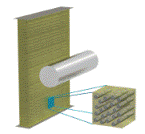Mechanical and Materials Engineering, Department of

Department of Engineering Mechanics: Dissertations, Theses, and Student Research
Date of this Version
5-2010
Document Type
Dissertation
Abstract
Characterizing the dynamic behavior of granular materials is one of the great challenges in the mechanics of granular matter. Methods for evaluating the mechanical properties of granular matter have applications in a variety of industries, mining and geotechnical activities, defense and military operations. A coupled 2D Discrete Element Method-Finite Element Method (DEM-FEM) code, called "BobKit", is developed and implemented for analyzing the behavior of a 2D granular layer on top of an elastic beam under deforming (quasi-static) or vibrating (dynamic) of the beam. The explicit time-integration dynamic code is used to simulate quasi-static and dynamic bending of the granular layer for close-packed monodispersed and random-packed polydispersed particles. In the DEM model of the granular particles we use and com- pare the results between two different contact force models: the linear spring-dashpot (Hookean contact) model, and the nonlinear spring-dashpot (Hertzian contact) model. In addition, the effect of the presence or absence of rolling resistance, due to rolling friction, is analyzed. Based on the contact force models used in the analyses, we propose a new way of computing the dissipative parameter in the Hertz model: we calibrate this parameter via a simple test of a dropped particle onto a rigid floor.
In quasi-static analysis, the structural changes of the force chains and the resonant behavior of granular layers in a 2D container with an elastic bottom are studied. The changes taking place in the structure of the force chains observed for both contact force models are qualitatively similar. The force chains generated during bending deformation form regions that can lead to enhance convection cells for more effective mixing and segregation in combined shaking/bending-vibrated granular media. We perform validation of the BobKit code by comparing the particle-size dependence of the bending stiffness of the granular-elastic beam system with analytical values from a quasi-static well-bonded model. In particular, when rolling resistance is included in the simulation, the results match very well the analytical model for the particle-size dependence for both contact force models. A dynamic analysis investigating the behavior of the granular layer/elastic beam system under resonant bending vibrations is also performed. Most computational studies of granular materials have been performed in rigid containers. The work in this dissertation is the first to investigate the evolution of the structural changes of the force chains under quasi-static bending deformation of a granular layer and dynamic-resonance of granular layers in a container with an elastic bottom. The code developed as part of this effort can be set up for varieties of particle simulations and easily extended to 3D analysis.
Included in
Engineering Mechanics Commons, Mechanical Engineering Commons, Mechanics of Materials Commons


Comments
A dissertation Presented to the Faculty of The Graduate College at the University of Nebraska In Partial Fulfillment of Requirements For the Degree of Doctor of Philosophy, Major: Engineering (Engineering Mechanics), Under the Supervision of Professor Florin Bobaru. Lincoln, Nebraska: May, 2010
Copyright (c) 2010 Kitti Rattanadit